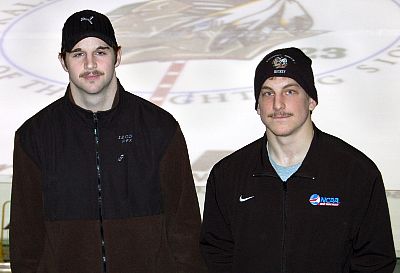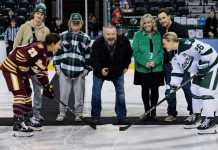At a time of the season when senior leadership becomes a prized commodity, North Dakota coach Dave Hakstol is thankful that two of his four seniors are still playing hockey.
Fighting Sioux defenseman Robbie Bina and forward Rylan Kaip each suffered injuries during their college hockey careers that left them questioning whether they’d ever again play the game they love. Hakstol says nobody can put a value on what they bring to the team.
“They’re both just such character guys,” he notes. “The best measure is the respect a player has within his own locker room and from his opponents. In both cases, they’re very well-respected by their peers.

“They go about their business in a very workmanlike way,” he says. “They go out and play hard. They’re both very tough competitors. They play it straight up and nose-to-nose.”
Bina’s injury, a broken neck, occurred March 18, 2005, during the WCHA Final Five in St. Paul. The incident generated widespread attention and caused the NCAA to reevaluate its hitting-from-behind rule, making it a point of emphasis.
In contrast, Kaip suffered a head injury in October 2004 during preseason practice. It wasn’t until late December that he was diagnosed with post-concussion syndrome, which MayoClinic.com describes as “a complex disorder in which concussion symptoms — such as headaches and dizziness — last for weeks and sometimes months after the impact that caused the concussion.”
In one day, Kaip — a Radville, Sask., native and Atlanta Thrashers draft choice — went from being a promising freshman forward playing a regular shift on UND’s third line to having his first season abruptly end and his hockey career cast in doubt.
Recalling the injury, Kaip says, “I went in for some stitches and took a couple days off because I might have gotten a concussion. I started playing again, and by the time December rolled around, the symptoms got to where I just couldn’t handle it any more.
“I was kind of playing in a fog and forgetting drills halfway through. My memory was shot and I was having headaches. It wasn’t a fun time at that point. It was December where it turned the switch and I couldn’t play.”
Kaip not only couldn’t play hockey, but he also discovered that he couldn’t practice or participate in any physical activity without getting migraine headaches. As the Sioux stormed through the NCAA regionals and into the 2005 NCAA Frozen Four championship game against Denver, all he could do was watch.
“It was kind of frustrating,” Kaip recalls. “It’s not like a broken leg where you have some sort of timeline and you’re able to check the progress. I had lots of teammate support, which made it a lot easier. Our team was going into the stretch run and I was able to enjoy the success of the team.”
Eventually, time and inactivity healed Kaip’s head injury
“If I would have kept getting little bumps in practice, it probably never would have healed,” he says. “That probably would have been it for hockey.
“I was able to stay away from hockey and that was probably the best decision,” Kaip recounts. “I just waited it out for four or five months and then I was able to play.”
Coming back to hockey after months of inactivity proved challenging.
“To come in the next year as a sophomore, I almost felt like I was a freshman again,” Kaip says. “I had to prove myself and earn ice time, which everyone has to do. It was difficult, but my teammates and the coaches made it easier.”
Today, Kaip wears a special helmet and makes certain his mouth guard is in while playing. He has been symptom-free since his return to the ice.
Not known as a scorer, he has a reputation as a tough, physical defensive forward and plays on UND’s second line with center Chris VandeVelde and forward Matt Watkins. More importantly, his teammates consider him their leader. They voted him assistant captain his junior year and captain this season.
“He’s not a guy that gets a lot of the spotlight,” Hakstol says of Kaip. “He was an overwhelming choice for captain this year. That’s the best compliment you can pay to a player. They know what he does day in and day out. They understand his commitment as a player and his commitment to team success.”
While Kaip’s injury and recovery occurred in relative obscurity, the public nature of Bina’s injury during the 2005 WCHA Final Five focused a great deal of attention on him that he didn’t particularly relish. Since his comeback, Bina has said little publicly about the incident.
Hakstol says Bina’s injury wasn’t only potentially career-ending, but it was also life-threatening. During a four-hour operation at Regions Medical Center in St. Paul, Dr. Daryll Dykes performed the surgery on Bina’s shattered C-7 vertebra. The entire vertebra was removed and the C-6 vertebra was fused to the T-1 vertebra.
Although he was forced to sit out the entire next season as a medical redshirt, the outcome for Bina seemed nearly miraculous.
“It was pretty much not too long after my surgery that the doctor told me that as long as everything healed up nicely, I’d be ready to go again in another year or so,” Bina recalls.
After most of a season spent practicing with the team wearing a “no hit” jersey, Bina returned to the ice Oct. 1, 2006, for an exhibition game at Ralph Engelstad Arena against the University of Manitoba. As the last player introduced, the hometown favorite received a thunderous standing ovation from Sioux fans.
“I was real excited to be able to get back out there and thankful that it wasn’t a career-ending thing,” Bina says. “Just being able to get back out there was great.”
As if getting Bina back wasn’t enough, his level of play during his junior season exceeded all expectations. He made good use of his year off from hockey.
“I think maybe it helped a little bit by being up in the stands during the games,” he explains. “You could watch the games closer and watch things develop better. I used that to my advantage when I finally got to play. I was able to watch things flow through and remember how it was when I was watching from up top and seeing how plays were developing.”
In his first two seasons, Bina recorded one goal and 16 assists. His first season back from a potentially career-ending injury, he scored 10 goals and had 22 assists. His 170-foot shorthanded goal against Minnesota became a YouTube.com favorite and ESPN SportsCenter’s No. 1 play of the day. He was also named to the 2007 NCAA West Regional All-Tournament Team.
This season, Bina has two goals and 22 assists. He was named to the All-WCHA Third Team last week.
One person who isn’t surprised by Bina’s success is Hakstol. He got what he expected when he recruited the undersized defenseman from the USHL.
“Every time we went to watch him, he was always the guy who made the right play,” Hakstol recalls. “There was nothing flashy about his game. It’s like it is now, only he’s become better.
“Maybe there weren’t high expectations for him. He’s out to prove to himself and people around him that he’s a good hockey player. He’s very quietly turned himself into one of the top defensemen in the country,” the Sioux coach says.
As UND heads to Madison for the NCAA Midwest Regional against Princeton on Saturday, both players are grateful for the opportunity to be part of another Sioux playoff run.
Bina says he’ll never forget the support he received from friends, family, the Grand Forks community and Sioux fans during his recovery.
“The support they showed every day at the rink and cheering for you, that’s just the experience that you want to be back for,” he says. “It’s part of the reason we want to play, just to have their support. It’s the excitement that they bring to the arena.”
For Kaip, struggling with the uncertainty of a recovering from a serious head injury was a life-enriching experience.
“The whole Sioux team and all the coaches were just like one big family,” he says. “To know that they’re there through the good and the bad is something special. I know that I’ll probably keep in touch with all these guys forever.”


